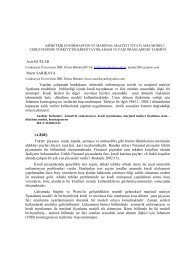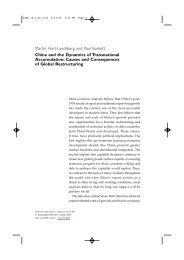where should we aim to prevent dangerous climate change?
where should we aim to prevent dangerous climate change?
where should we aim to prevent dangerous climate change?
Create successful ePaper yourself
Turn your PDF publications into a flip-book with our unique Google optimized e-Paper software.
difficulty coping. Since the end of the last ice age and the rise of human civilisation over the last 8000years, the <strong>climate</strong> has been comparatively stable and benign but there have nevertheless been timeswhen civilisations have collapsed due <strong>to</strong> <strong>climate</strong> <strong>change</strong>. Near-term temperature increases of a lot lessthan 2ºC may bring some human societies undone, so careful attention <strong>should</strong> be paid <strong>to</strong> at least threeuseful indica<strong>to</strong>rs of <strong>dangerous</strong> <strong>climate</strong> <strong>change</strong>. These are <strong>change</strong>s that:• exceed the capacity of human societies and other species <strong>to</strong> cope with <strong>climate</strong> or otheratmosphere-mediated challenges (such as ocean acidification) and <strong>to</strong> recover from theimpacts;• trigger positive feedbacks (such as the loss of the Arctic sea ice triggering Greenland ice-sheetdisintegration) which by themselves would be enough <strong>to</strong> take the temperature and otherenvironmental conditions <strong>to</strong> a <strong>dangerous</strong> environmental state; or• reduce the capacity of natural carbon sinks.Defining the safe zone: So how <strong>should</strong> <strong>we</strong> define the safe zone?The first step would be <strong>to</strong> use precautionary rules-of-thumb <strong>to</strong> provide a crude sense of the possibleouter boundaries. We know that over the last million years that the global average temperature hasnot been more than 1ºC above the present temperature, that is, more than 1.8 ºC over the preindustriallevel, that CO 2 levels take many decades <strong>to</strong> produce their full (equilibrium) warming effect,and that <strong>we</strong> have another at least 0.6ºC of warming still <strong>to</strong> come from the greenhouse gases in the airnow. We also know that over the last million years the CO 2 level in the atmosphere has not been morethan 300ppm, and that while temperatures have been somewhat higher before, CO 2 levels are nownearly 30% higher than at any time in the last million years. Using these very rough indica<strong>to</strong>rs of apossible safe zone boundary, with the atmospheric CO 2 level at 383ppm <strong>we</strong> are clearly already <strong>we</strong>lloutside the CO 2 paleohis<strong>to</strong>ry precautionary boundary of 300ppm, and with a warming of 1.4 ºCalready largely locked in (0.8ºC current + 0.6ºC in the pipeline) <strong>we</strong> are very close <strong>to</strong> the temperaturepaleohis<strong>to</strong>ry precautionary boundary of 1.8 ºC over the pre-industrial level.But <strong>we</strong> can also consider more specific data and emerging conditions which strongly suggest that <strong>we</strong>are much closer <strong>to</strong> a <strong>we</strong>ll-calibrated boundary of the safe zone than <strong>we</strong> might have thought, indeed<strong>we</strong> may have already passed over the <strong>we</strong>ll-calibrated boundary.We know from the current state of the environment that carbon sinks are becoming less effective,conditions for food production are deteriorating, and conditions for other species are worsening dueespecially <strong>to</strong> spreading desertification and increased fire intensity, frequency and geographicalspread. The increasing incidence of major natural disasters associated with <strong>climate</strong> <strong>change</strong> –described as being a “<strong>climate</strong> mega-disaster” by the United Nation's emergency relief coordina<strong>to</strong>r – isleading <strong>to</strong> donor fatigue and stretching the normal capacity of societies <strong>to</strong> cope.One aspect worth examining in detail is the implications of the collapse of the Arctic sea ice thatbecame so clearly apparent this northern summer when the minimum ice extend plunged a further22% below the previous record low in 2005.It seems the Arctic is now routinely warm enough <strong>to</strong> eliminate all the remaining sea ice in summerwithout any need for the stimulus of further additions of greenhouse gases. It is already known that itwill be very damaging <strong>to</strong> lose the Arctic sea ice in summer as this will means that the Arctic Oceanwill no longer reflect most of the incoming solar radiation, but instead will become an effectiveabsorber of most of the that energy. This physically very large “albedo switch” will lead <strong>to</strong> furtherwarming in the Arctic of several degrees which will contribute <strong>to</strong> the destabilization of the Greenlandice sheet, adding <strong>to</strong> positive feedbacks already operating (such as the release of methane and CO 2 as aresult of the melting of permafrost). Over the next century very large volumes of water are expected<strong>to</strong> be lost from Greenland leading <strong>to</strong> metres of sea level rise. There can be no doubt that such sea levelrises constitute <strong>dangerous</strong> <strong>climate</strong> <strong>change</strong> for, at a minimum, hundreds of millions of humans andmany coastal species.It is now clear that the process of ice mass loss from the Arctic began at least two decades ago. Thetemperature at this time was about 0.5ºC above the pre-industrial level. So it seems reasonable, basedon concern <strong>to</strong> maintain the solar reflec<strong>to</strong>r value of the Arctic sea ice, that <strong>we</strong> must keep temperatures<strong>to</strong> no more than 0.5ºC warming over the pre-industrial level. Furthermore, taking this as themaximum warming cap, <strong>we</strong> can determine using the 3ºC <strong>climate</strong> sensitivity standard that the longrunmaximum level of CO 2 e needs <strong>to</strong> be no more than 320ppm.Target practice: <strong>where</strong> <strong>should</strong> <strong>we</strong> <strong>aim</strong> <strong>to</strong> avoid <strong>dangerous</strong> <strong>climate</strong> <strong>change</strong>? 19





